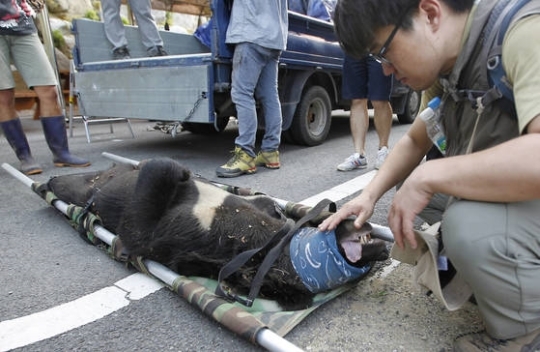The freedom of the Asian black bear tagged KM-53 is fueling discord between environmental activists and the government over the bear restoration project.

The bear in question was released into the mountainous Jirisan for species restoration, but was found 80 kilometers away, raising concerns of both human safety and habitat protection.
In 2004, the Ministry of Environment’s Species Restoration Technology Institute launched the bear restoration project at Jirisan in South Gyeongsang Province to release young bears into the wild.
The mountain Jirisan was previously home to many Asian black bears, but habitat destruction forced the species into extinction in Korea.
Thanks to the project, there are currently 47 bears on Jirisan with chips implanted that enable authorities to monitor their whereabouts.
KM-53, however, was found by a mountain trail on Sudosan in Gimcheon, North Gyeongsang Province, some 80 kilometers from the original Mount Jiri habitat.
Authorities say they had lost track of the bear in September, due to the GPS failure of the chip. The bear was spotted in the foothills of Sudosan, eating food from nearby houses. It had not caused injury to any humans, officials said.
Earlier this month, the bear was relocated back to Jirisan, but two weeks later the bear was found once again at Sudosan.
Currently, the bear is in captivity at Jirisan, and authorities plan to keep the animal in captivity permanently if it is deemed a risk to again leave the Jirisan area.
But environmental activists say the animal should be set free at Sudosan, as the bear appears to want to settle in the new habitat.
They also argue that the incident reveals flaws in current restoration policies.
“The ministry should create a better environment for bears to live. The bears are moving north because they are under the influence of a shrinking habitat on Jirisan, which at least 3 million hikers visit each year,” the National Park Conservation Network said in a statement.
They say the bear’s migration to another region is unusual, considering the typical radius of the bear’s activities is less than 15 kilometers.
The bear is believed to have passed through Gwangju-Daegu Expressway and Daejeon-Tongyeong Expressway to reach Sudosan, according to the ministry.
Meanwhile, it was also revealed last week that more than half of 47 bears at the Jirisan habitat were not being monitored by the ministry.
According to Rep. Lee Jeong-mi of the Justice Party, 28 of 47 bears were not detectable because 15 were newborns not implanted with GPS chips and another 13 had dead batteries for the chip.
So far, there have been 390 reports of damage caused by the bears since the government spearheaded the bear restoration project in 2004, Rep. Lee said.
By Kim Da-sol (ddd@heraldcorp.com)







![[Graphic News] More Koreans say they plan long-distance trips this year](http://res.heraldm.com/phpwas/restmb_idxmake.php?idx=644&simg=/content/image/2024/04/17/20240417050828_0.gif&u=)
![[KH Explains] Hyundai's full hybrid edge to pay off amid slow transition to pure EVs](http://res.heraldm.com/phpwas/restmb_idxmake.php?idx=644&simg=/content/image/2024/04/18/20240418050645_0.jpg&u=20240419100350)






![[From the Scene] Monks, Buddhists hail return of remains of Buddhas](http://res.heraldm.com/phpwas/restmb_idxmake.php?idx=652&simg=/content/image/2024/04/19/20240419050617_0.jpg&u=20240419175937)

![[KH Explains] Hyundai's full hybrid edge to pay off amid slow transition to pure EVs](http://res.heraldm.com/phpwas/restmb_idxmake.php?idx=652&simg=/content/image/2024/04/18/20240418050645_0.jpg&u=20240419100350)

![[Today’s K-pop] Illit drops debut single remix](http://res.heraldm.com/phpwas/restmb_idxmake.php?idx=642&simg=/content/image/2024/04/19/20240419050612_0.jpg&u=)